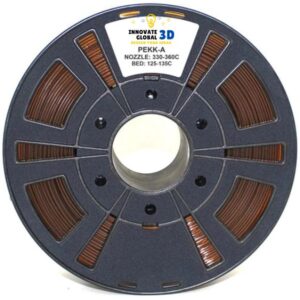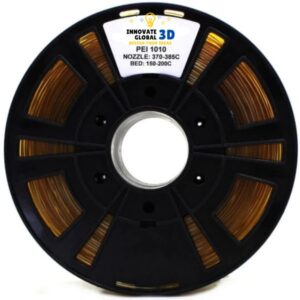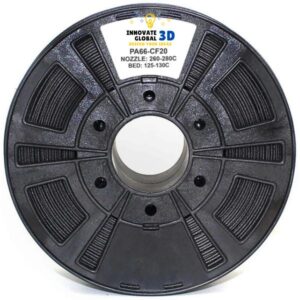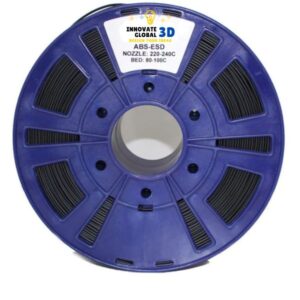ABS-ESD | Exclusive Professional-Quality Reinforced Filament-2
AUD$362.00
ABS-ESD is an advanced ESD-Safe compound designed for use in critical applications which require electrostatic discharge (ESD) protection and a high level of cleanliness. Manufactured with consistency in mind, We use premium quality ABS and then compound it with a proprietary formulation of multi-wall carbon nanotubes – giving you a filament with excellent printability and consistent ESD properties.
ABS-ESD is an advanced ESD-Safe compound designed for use in critical applications which require electrostatic discharge (ESD) protection and a high level of cleanliness. Manufactured with consistency in mind, We use premium quality ABS and then compound it with a proprietary formulation of multi-wall carbon nanotubes – giving you a filament with excellent printability and consistent ESD properties. It is Professional-Quality Reinforced Filament
Benefits of ABS-ESD
- Durable and sturdy parts of every open-source machine on the market
- It is Easy to print than most industrial-grade materials
- Better thermal properties than PLA or PETG
- Easy solution for prototyping or end-use parts among both industry engineers and hobbyists alike
Benefits of ABS-ESD Include:
- It Gives Consistent surface resistivity
- Retention of impact & elongation when compared with the carbon fiber matrix
- It has Low particulate contamination
- It has minimal contribution to outgassing and ionic contamination
Typical ABS-ESD Applications Include:
- Semi-con: HDD Components, Wafer Handling, Jigs, Connectors & Connectors
- Industrial: Conveying, Metering, and Sensing Applications
Target Conductivity for ABS-ESD:
- 10^7 to 10^9 ohm surface resistivity on a 3D Printing sample (made on a Funmat-HT 3d Printer) and tested the sample using the concentric ring test method.
- Note: Internal studies have indicated that increased extruder temperatures can achieve higher levels of conductivity. Likewise, lower extruder temperatures have resulted in lower levels of conductivity. Each printer is set up differently as well as varied part geometry. Therefore, expect some trial time to understand how ABS-ESD filament works in your specific printer/application.
Surface Conductivity as a Function of Extruder Temperature:
The surface resistance of the printed ESD-safe part will vary depending on the printer’s extruder temperature. For example, if your testing indicates the part is too insulative, then increasing the extruder temperature will result in improved conductivity. Therefore, the surface resistance can be ‘dialed-in’ by adjusting the extruder temperature up or down depending on the reading you receive on your ABS-ESD part.

Filament Specifications:
1.75mm +/- 0.05mm in diameter

Recommended Print Settings:
- Extruder: 220-240°C
- Bed Temp: 100-110°C
- Bed Prep: PEI-Sheet, Rough Borosilicate Glass with PVP gluestick, or high temp carbon fiber sheet plus PVP glue stick, we also recommend the Vision Miner Nano Polymer Adhesive.
- Heated Chamber: Recommended, a chamber helps reduce warping.
- Other: Increasing your extrusion multiplier up to 1.15 or even 1.2 and varying your fan speed between 50-100% may be necessary.
- Nozzle: We strongly recommend a 0.4mm orifice or larger using one of our Carbide nozzles as carbon nanotubes are mildly abrasive.
- Drying Instructions: 80°C for 4 hours.
Here’s the table summarizing the details for ABS-ESD:
| Category | Details |
| Material | ABS-ESD |
| Description | Advanced ESD-Safe compound for critical applications requiring electrostatic discharge protection and cleanliness. |
| Manufacturing | Premium ABS compounded with multi-wall carbon nanotubes for excellent printability and consistent ESD properties. |
| Benefits | · Durable and sturdy parts
· Easy to print · Better thermal properties than PLA or PETG · Ideal for prototyping or end-use parts |
| Key Features | 1. Consistent surface resistivity
2. Retains impact & elongation properties 3. Low particulate contamination 4. Minimal outgassing and ionic contamination |
| Applications | –Semiconductor: HDD components, wafer handling, jigs, connectors –Industrial: Conveying, metering, sensing |
| Target Conductivity | 10^7 to 10^9 ohm surface resistivity on a 3D printed sample (tested via concentric ring method). |
| Effect of Extruder Temperature | -Higher extruder temp: Improved conductivity -Lower extruder temp: Reduced conductivity |
| Filament Specifications | 1.75mm +/- 0.05mm. |
| Recommended Print Settings | · Extruder Temperature: 220-240°C
· Bed Temp: 100-110°C · Bed Prep: PEI-Sheet, rough borosilicate glass with PVP glue stick, or high-temp carbon fiber sheet with PVP glue stick. · Heated Chamber: Recommended to reduce warping · Nozzle: 0.4mm or larger carbide nozzle · Drying: 80°C for 4 hours |
| Special Recommendations | -Increase extrusion multiplier (1.15-1.2) -Vary fan speed (50-100%) |
1. What is ABS-ESD?
ABS-ESD is an advanced electrostatic discharge (ESD)-safe 3D printing filament designed for critical applications requiring ESD protection and cleanliness. It is made by compounding premium ABS with multi-wall carbon nanotubes for consistent performance and printability.
2. What are the key benefits of ABS-ESD?
- Durable and sturdy parts on most open-source 3D printers.
- Easy to print compared to industrial-grade materials.
- Superior thermal properties over PLA or PETG.
- Ideal for prototyping or end-use parts for engineers and hobbyists alike.
3. What makes ABS ESD suitable for sensitive applications?
ABS-ESD offers:
- Consistent surface resistivity.
- Retention of impact and elongation properties.
- Low particulate contamination.
- Minimal outgassing and ionic contamination.
4. What are the common applications of ABS ESD?
- Semiconductor Industry: HDD components, wafer handling tools, jigs, connectors, and fixtures.
- Industrial Applications: Conveying, metering, and sensing equipment.
5. What is the target conductivity range of ABS ESD?
The target surface resistivity is 10⁷ to 10⁹ ohms, tested using the concentric ring method on a sample printed with a Funmat-HT 3D printer.
6. Can the conductivity be adjusted during printing?
Yes, conductivity can be adjusted by varying the extruder temperature:
- Higher temperature: Improves conductivity.
- Lower temperature: Reduces conductivity.
7. What are the filament specifications for ABS-ESD?
- Diameter: 1.75mm
- Tolerance: ±0.05mm
8. What are the recommended print settings for ABS ESD?
- Extruder Temperature: 220-240°C
- Bed Temperature: 100-110°C
- Bed Prep: PEI-Sheet, rough borosilicate glass with PVP glue stick, or high-temp carbon fiber sheet with PVP glue stick.
- Heated Chamber: Recommended to reduce warping.
- Nozzle: 0.4mm or larger carbide nozzle.
- Drying Instructions: 80°C for 4 hours before printing.
9. Is a heated chamber required for printing ABS ESD?
While not mandatory, using a heated chamber is recommended to minimize warping and ensure optimal print quality.
10. Is ABS-ESD abrasive to printer nozzles?
Yes, due to the carbon nanotubes, ABS ESD is mildly abrasive. We recommend using a carbide nozzle for durability.
11. How do I improve print quality with ABS ESD?
- Increase the extrusion multiplier (1.15-1.2).
- Adjust fan speed between 50-100% as needed.
12. Does Innovate3Dglobal Pty Ltd provide support for ABS.-ESD users?
Yes, Innovate3Dglobal offers technical support to help you optimize ABS ESD for your specific printer and applications. See More
| Weight | 1 kg |
|---|







Reviews
There are no reviews yet.